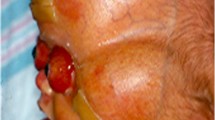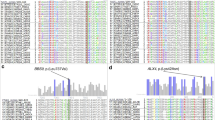Abstract
Muenke syndrome, also known as FGFR3-associated coronal synostosis, is defined molecularly by the presence of a heterozygous nucleotide transversion, c.749C>G, encoding the amino acid substitution Pro250Arg, in the fibroblast growth factor receptor type 3 gene (FGFR3). This frequently occurs as a new mutation, manifesting one of the highest documented rates for any transversion in the human genome. To understand the biology of this mutation, we have investigated its parental origin, and the ages of the parents, in 19 families with de novo c.749C>G mutations. All ten informative cases originated from the paternal allele (95% confidence interval 74–100% paternal); the average paternal age at birth overall was 34.7 years. An exclusive paternal origin of mutations, and increased paternal age, were previously described for a different mutation (c.1138G>A) of the FGFR3 gene causing achondroplasia, as well as for mutations of the related FGFR2 gene causing Apert, Crouzon and Pfeiffer syndromes. We conclude that similar biological processes are likely to shape the occurrence of this c.749C>G mutation as for other mutations of FGFR3 as well as FGFR2.




Similar content being viewed by others
References
Anderson J, Burns HD, Enriquez-Harris P, Wilkie AOM, Heath JK (1998) Apert syndrome mutations in fibroblast growth factor receptor 2 exhibit increased affinity for FGF ligand. Hum Mol Genet 7:1475–1483
Bailey DMD, Affara NA, Ferguson-Smith MA (1992) The X-Y homologous gene Amelogenin maps to the short arms of both the X and Y chromosomes and is highly conserved in primates. Genomics 14:203–205
Bellus GA, Hefferon TW, Ortiz de Luna RI, Hecht JT, Horton WA, Machado M, Kaitila I, McIntosh I, Francomano CA (1995) Achondroplasia is defined by recurrent G380R mutations of FGFR3. Am J Hum Genet 56:368–373
Bellus GA, Gaudenz K, Zackai EH, Clarke LA, Szabo J, Francomano CA, Muenke M (1996) Identical mutations in three different fibroblast growth factor receptor genes in autosomal dominant craniosynostosis syndromes. Nat Genet 14:174–176
Cohen MM Jr, Krieborg S, Lammer EJ, Cordero JF, Mastroiacovo P, Erickson JD, Roeper P, Martínez-Frías ML (1992) Birth prevalence study of the Apert syndrome. Am J Med Genet 42:655–659
Crow JF (2000) The origins, patterns and implications of human spontaneous mutation. Nat Rev Genet 1:40–47
Dib C, Faure S, Fizames C, Samson D, Drouot N, Vignal A, Millasseau P, Marc S, Hazan J, Seboun E, Lathrop M, Gyapay G, Morissette J, Weissenbach J (1996) A comprehensive genetic map of the human genome based on 5,264 microsatellites. Nature 380:152–154
Garcia-Miñaur S, Mavrogiannis LA, Rannan-Eliya SV, Hendry MA, Liston WA, Porteous MEM, Wilkie AOM (2003) Parietal foramina with cleidocranial dysplasia is caused by mutation in MSX2. Eur J Hum Genet 11:892–895
Glaser RL, Broman KW, Schulman RL, Eskenazi B, Wyrobek AJ, Jabs EW (2003) The paternal-age effect in Apert syndrome is due, in part, to the increased frequency of mutations in sperm. Am J Hum Genet 73:939–947
Glaser RL, Jiang RL, Boyaddiev SA, Tran AK, Zachary AA, Van Maldergem L, Johnson D, Walsh S, Oldridge M, Wall SA, Wilkie AOM, Jabs EW (2000) Paternal origin of FGFR2 mutations in Sporadic cases of Crouzon syndrome and Pfeiffer Syndrome. Am J Hum Genet 66:768–777
Goriely A, McVean GA, Röjmyr M, Ingemarsson B, Wilkie AOM (2003) Evidence for selective advantage of pathogenic FGFR2 mutations in the male germ line. Science 301:643–646
Graham JM Jr, Braddock SR, Mortier GR, Lachman R, Van Dop C, Jabs EW (1998) Syndrome of coronal craniosynostosis with brachydactyly and carpal/tarsal coalition due to Pro250Arg mutation in FGFR3 gene. Am J Med Genet 77:322–329
Gripp KW, McDonald-McGinn DM, Gaudenz K, Whitaker LA, Bartlett SP, Glat PM, Cassileth LB, Mayro R, Zackai EH, Muenke M (1998) Identification of a genetic cause for isolated unilateral coronal synostosis: a unique mutation in the fibroblast growth factor receptor 3. J Pediatr 132:714–716
Henderson S, Sillence D, Loughlin J, Bennetts B, Sykes B (2000) Germline and somatic mosaicism in achondroplasia. J Med Genet 37:956–958
Hyland VJ, Robertson SP, Flanagan S, Savarirayan R, Roscioli T, Masel J, Hayes M, Glass IA (2003) Somatic and germline mosaicism for a R248C missense mutation in FGFR3, resulting in a skeletal dysplasia distinct from thanatophoric dysplasia. Am J Med Genet 120A:157–168
Ibrahimi OA, Eliseenkova AV, Plotnikov AN, Yu K, Ornitz DM, Mohammadi M (2001) Structural basis for fibroblast growth factor receptor 2 activation in Apert syndrome. Proc Natl Acad Sci U S A 98:7182–7187
Ibrahimi OA, Zhang F, Eliseenkova AV, Linhardt RJ, Mohammadi M (2004) Proline to arginine mutations in FGF receptors 1 and 3 result in Pfeiffer and Muenke craniosynostosis syndromes through enhancement of FGF binding affinity. Hum Mol Genet 13:69–78
Keegan K, Johnson DE, Williams LT, Hayman MJ (1991) Isolation of an additional member of the fibroblast growth factor receptor family, FGFR-3. Proc Natl Acad Sci U S A 88:1095–1099
Kondrashov AS (2003) Direct estimates of human per nucleotide mutation rates at 20 loci causing Mendelian diseases. Hum Mutat 21:12–27
Kwok S, Kellogg DE, McKinney N, Spasic D, Goda L, Levenson C, Sninsky JJ (1990) Effects of primer-template mismatches on the polymerase chain reaction: human immunodeficiency virus type 1 model studies. Nucleic Acids Res 18:999–1005
Lajeunie E, El Ghouzzi V, Le Merrer M, Munnich A, Bonaventure J, Renier D (1999) Sex-related expressivity of the phenotype in coronal craniosynostosis caused by the recurrent P250R FGFR3 mutation. J Med Genet 36:9–13
Moloney DM, Slaney SF, Oldridge M, Wall SA, Sahlin P, Stenman G, Wilkie AOM (1996) Exclusive paternal origin of new mutations in Apert syndrome. Nat Genet 13:48–53
Moloney DM, Wall SA, Ashworth GJ, Oldridge M, Glass IA, Francomano CA, Muenke M, Wilkie AOM (1997) Prevalence of Pro250Arg mutation of fibroblast growth factor receptor 3 in coronal craniosynostosis. Lancet 349:1059–1062
Muenke M, Gripp KW, McDonald-McGinn DM, Gaudenz K, Whitaker LA, Bartlett SP, Markowitz RI, Robin NH, Nwokoro N, Mulvihill JJ, Losken HW, Mulliken JB, Guttmacher AE, Wilroy RS, Clarke LA, Hollway G, Adès LC, Haan EA, Mulley JC, Cohen MM Jr, Bellus GA, Francomano CA, Moloney DM, Wall SA, Wilkie AOM, Zackai EH (1997) A unique point mutation in the fibroblast growth factor receptor 3 gene (FGFR3) defines a new craniosynostosis syndrome. Am J Hum Genet 60:555–564
Nachman MW, Crowell SL (2000) Estimate of the mutation rate per nucleotide in humans. Genetics 156:297–304
Newton CR, Graham A, Heptinstall LE, Powell SJ, Summers C, Kalsheker N, Smith JC, and Markham AF (1989) Analysis of any point mutation in DNA: the amplification refractory mutation system (ARMS). Nucleic Acids Res 17:2503–2516
Office of Population Censuses and Surveys (1984–2000) Birth Statistics, series FM1, Table 3.4. HMSO, London
Oldridge M, Lunt PW, Zackai EH, McDonald-McGinn DM, Muenke M, Moloney M, Twigg SRF, Heath JK, Howard TD, Hoganson G, Gagnon DM, Jabs EW, Wilkie AOM (1997) Genotype-phenotype correlation in the IgII-IgIII linker of FGFR2. Hum Mol Genet 6:137–143
Perez-Castro AV, Wilson J, Altherr MR (1997) Genomic organization of the human fibroblast growth factor receptor 3 (FGFR3) gene and comparative sequence analysis with the mouse Fgfr3 gene. Genomics 41:10–16
Rannan-Eliya S (2002) The genetics of craniosynostosis: the role of mutation in RUNX2 and FGFR3 genes. MSc thesis, University of Oxford
Reardon W, Wilkes D, Rutland P, Pulleyn LJ, Malcolm S, Dean JCS, Evans RD, Jones BM, Hayward R, Hall CM, Nevin NC, Baraitser M, Winter RM (1997) Craniosynostosis associated with FGFR3 pro250arg mutation results in a range of clinical presentations including unisutural sporadic craniosynostosis. J Med Genet 34:632–636
Registrar General’s statistical review of England and Wales (1965, 1971) Part II, tables, population, Table AA. HMSO, London
Robin NH, Scott JA, Cohen AR, Goldstein JA (1998) Nonpenetrance in FGFR3-associated coronal synostosis syndrome. Am J Med Genet 80:296–297
Sobetzko D, Braga S, Rüdeberg A, Superti-Furga A (2000) Achondroplasia with the FGFR3 1138 g?a (G380R) mutation in two sibs sharing a 4p haplotype derived from their unaffected father. J Med Genet 37:958–959
Tartaglia M, Saulle E, Bordoni V, Battaglia PA (1998) Polymorphism at position 882 of the fibroblast growth factor receptor 3 (FGFR3) gene detected by SSCP analysis. Mol Cell Probes 12:335–337
Tolarova MM, Harris JA, Ordway DE, Vargervik K (1997) Birth prevalence, mutation rate, sex ratio, parents’ age, and ethnicity in Apert syndrome. Am J Med Genet 72:394–398
Tiemann-Boege I, Navidi W, Grewal R, Cohn D, Eskenazi B, Wyrobek AJ, Arnheim N (2002) The observed human sperm mutation frequency cannot explain the achondroplasia paternal age effect. Proc Natl Acad Sci USA 99:14952–14957
Wilkin DJ, Szabo JK, Cameron R, Henderson S, Bellus GA, Mack ML, Kaitila I, Loghlin J, Munnich A, Sykes B, Bonaventure K, Francomano CA (1998) Mutations in fibroblast growth factor receptor 3 in sporadic cases of achondroplasia occur exclusively on the paternally derived chromosome. Am J Hum Genet 63:711–716
Wüchner C, Hilbert K, Bernhard Z (1997) Human fibroblast growth factor receptor 3 (FGFR3) gene: genomic sequence and primer set information for gene analysis. Hum Genet 100:215–219
Yu K, Herr AB, Waksman G, Ornitz DM (2000) Loss of fibroblast growth factor receptor 2 ligand-binding specificity in Apert syndrome. Proc Natl Acad Sci U S A 97:14536–14541
Acknowledgements
We are very grateful to the families for their participation in this study, Dr. J. Hoogeboom (Rotterdam), Dr. R. Newbury-Ecob and Dr. L. Mauceri for referral of families, A.L.W. Janssen for the original mutation analysis of the Dutch cases, and E. Bochukova, A. Goriely and R Hansen for comments on the manuscript. This work was supported by the Wellcome Trust (AOMW).
Author information
Authors and Affiliations
Corresponding author
Additional information
S.V. Rannan-Eliya and I.B. Taylor contributed equally to this work.
Rights and permissions
About this article
Cite this article
Rannan-Eliya, S.V., Taylor, I.B., de Heer, I.M. et al. Paternal origin of FGFR3 mutations in Muenke-type craniosynostosis. Hum Genet 115, 200–207 (2004). https://doi.org/10.1007/s00439-004-1151-5
Received:
Accepted:
Published:
Issue Date:
DOI: https://doi.org/10.1007/s00439-004-1151-5




